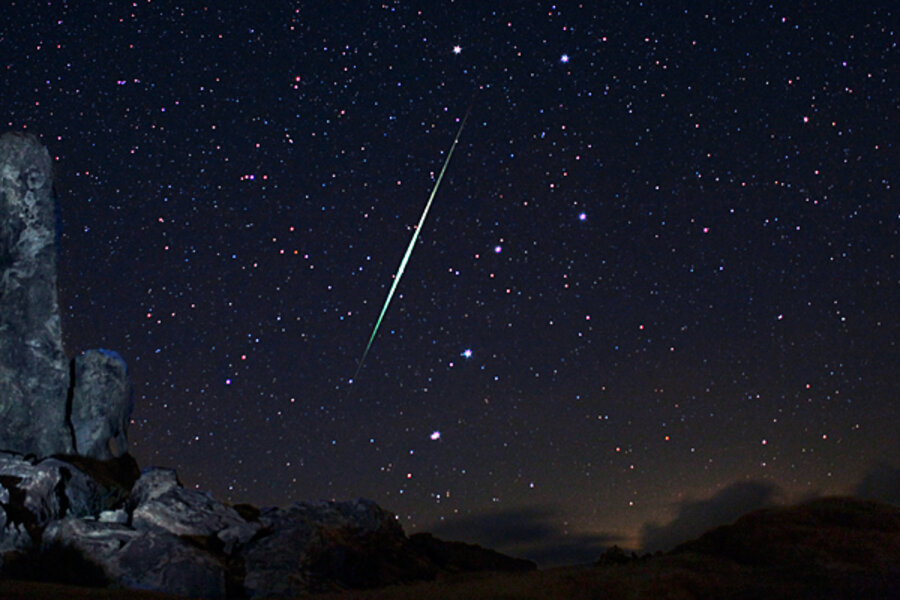Geminid meteor shower 2010: Why is the Phaethon asteroid going to pieces?
Loading...
The Geminid meteor shower for 2010 peaks overnight Monday with what promises to be a spectacular show for sky watchers who find themselves under clear, dark skies with an unobstructed view of the horizon.
By some estimates, the Geminid meteor shower – so named because they appear to the observer to be emanating from the constellation Gemini – could yield up to 120 shooting stars an hour for those watching under ideal viewing conditions between midnight and dawn Tuesday.
For astronomy buffs, the Geminids often provide the best meteor-shower show of the year. For some astronomers, however, the display and its source – an asteroid known as 3200 Phaethon – represent something of a mystery: Where did this asteroid come from and why does it appear to be shedding like a golden retriever, something asteroids generally don't do?
"The whole thing is very weird," says David Jewitt, an astronomer at the University of California at Los Angeles who studies comets and asteroids.
Phaethon is a near-Earth asteroid – an object some three miles across whose orbit around the sun each 1.4 years brings it close to Earth's orbit and to within 13 million miles of the sun, well inside Mercury's orbit.
Astronomers discovered Phaethon in 1983 using a space-based infrared telescope known as IRAS. Once researchers had calculated the asteroid's orbit, the late astronomer and comet specialist Fred Whipple noticed that its path matched that of the debris stream that generates the Geminid shower.
That appeared to solve a problem, Dr. Jewitt explains, since until then, no one had identified a source of the material forming the Geminids.
Meteor showers typically stem from dust and rocks that comets shed as they approach the sun. They heat up, the ices they carry flash from ice to gas, and as the gas vents through the comet's surface, it carries dust and debris with it. No one had been able to associate a comet with the Geminid debris stream.
But that raised another question: Why is Phaethon shedding? Asteroids don't tend to do that. Astronomers looked for signs that it might have a small halo of gas around it, similar to a comet's "coma." But none appeared. Indeed, over the years, the object has yielded no evidence of activity that would eject material.
Then last year, Dr. Jewitt and colleague Jing Li received an alert from another colleague that Phaethon had brightened suddenly as it reached its closest approach to the sun.
Jewitt and Dr. Li captured images of Phaethon with NASA's STEREO-A spacecraft – one of a pair of sun-watching probes. They observed the brightening and proposed that Phaethon's flash occurred as it shed rocky material fractured by the heat of its close approach to the sun.
In effect, the researchers say, the object is a "rock comet" rather than an icy "dirty snowball" or "snowy dirt ball" comet. The duo published its results in November in the Astronomical Journal.
As for Phaethon's origins, another team led by Julia Maria de León Cruz at the Institute of Astrophysics of Andalusia in Grenada, Spain, suggests that Phaethon may be a chip off Pallas, a 340-mile-wide asteroid in the main asteroid belt, which circles the sun between Mars and Jupiter.
Although Phaethon and Pallas don't share the same overall color, a first-cut clue as to their surface composition, Phaethon does share more-detailed spectral signatures of nine other, smaller asteroids near Pallas that are associated with it. They posit that Phaethon and its nine siblings constitute debris left over from a collision between Pallas and another object in an event that would have carved a sizable crater into Pallas.
The Grenada team published its study in April in the journal Astronomy and Astrophysics.
It's still unclear if Phaethon is shedding enough material to continually resupply the Geminid meteor stream, Jewitt acknowledges. The stream is about 1,000 years old. Phaethon would have to undergo at least 10 such shedding events each orbit over that time to provide enough material to sustain the Geminid shower that humans observe today. So far, astronomers have observed just one.
More broadly, Phaethon could be opening a window on a little-understood process that marks the end of the line for many asteroids and comets.
"We know small bodies can be destroyed in different ways," Jewitt says. Collisions can break them apart. Comets can run out of gas, their cores becoming dark hulks orbiting the sun. Asteroids and comets can end in fiery plunges into the sun. And comets can get disrupted by planets' gravity and break apart.
With Phaethon however, astronomers may be witnessing that Jewitt calls spontaneous disintegration. "Its a physical decay," he says. "They fall to bits, for reasons which are unclear."
Not a promising future from Phaethon's perspective. But for Earthlings, that slow-mo crumble can put on a good show.





